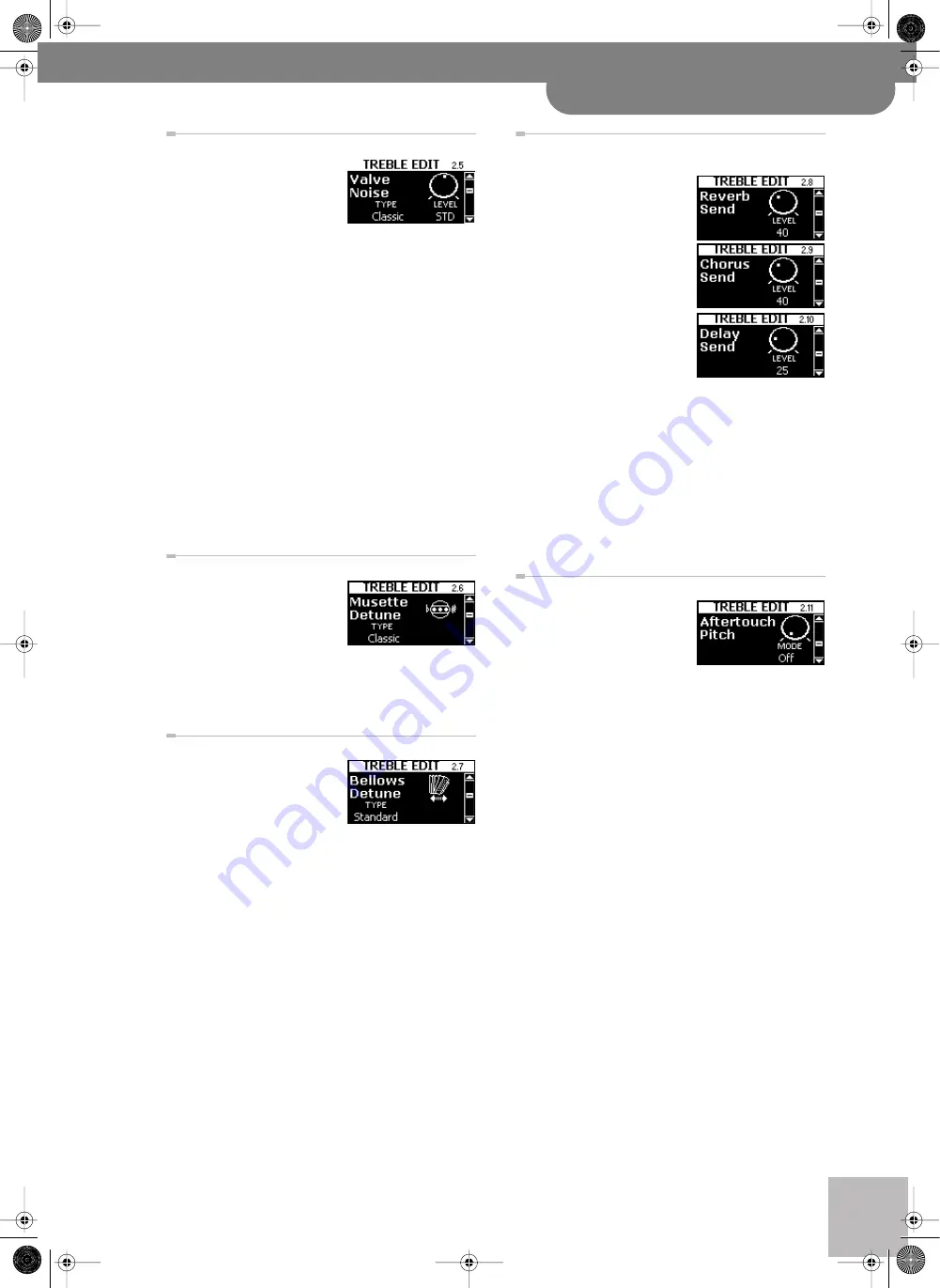
2.5 Valve Noise (Advanced)
V-Accordion
r
67
This is a more elaborate ver-
sion of the “Noise” parameter
discussed on page 37. It allows
you to not only set the level of
the “typical” valve noises, but
also to specify what kind of instrument should generate
the noise.
You are free to experiment with any noise type you like,
but using the noise related to the selected instrument
(see “2.1 Reed Type” on p. 65) is usually more realistic.
There is only one “
TYPE
” for the entire register (i.e. all 7
reeds). The options are: Bandoneon, I-Folk, I-Folk2,
Classic, Cajun, Jazz, F-Folk, D-Folk, Organetto, F-Folk2,
Classic2, Studio, Tradition, Steierische, OldItaly, TexMex,
Trikitixa, F-Jazz, Classic3, Bajan.
Use the
LEVEL
parameter to specify how prominent the
noise should be (Off, –40~“Std”~40, Default setting:
Std).
Note:
Whenever you select “ALL” for “2.1 Reed Type” and set a
different reed type, this noise setting is automatically adapted
to the reed type. It would therefore be a good idea to first
select the reed type and only then change the noise type.
This parameter allows you to
choose the system used for
detuning the 8’ reeds. See
page 35 for details.
The options are: Off, Dry, Clas-
sic, F-Folk, American_L, American_H, North_Eur,
German_L, D-Folk_L, Italian_L, German_H, Alpine,
Italian_H, D-Folk_H, French, Scottish.
(Off, Low, Standard, High,
Default setting: Standard)
This parameter further adds to
the realism of the sounds
emulated by your FR-7x. Here,
you can specify how strongly the pitch of the simulated
Treble reed(s) changes when you open or close the bel-
lows faster than usual.
If the “Standard” setting seems too mild, try “High”. If it
is too strong, use “Low”. If you don’t want any detuning
effect, select “Off”. The most convincing setting usually
depends on the selected instrument(s) (see “2.1 Reed
Type” on p. 65).
2.8 Reverb Send, 2.9 Chorus Send,
2.10 Delay Send
(0~127 for all three)
Use these parameters to set
the Reverb, Chorus or Delay
send levels (how much effect
should be applied to the Treble
section). The higher the value
you set, the more the Treble
section is processed by the
effect in question.
It works much the same way
as a cathedral: the louder you
sing, the more reverb (chorus
or delay) you hear. In the case
of the cathedral, singing louder means that you increase
the effect send level, i.e. the level of the signal (your
voice) that will be processed by the acoustic environ-
ment.
The other sections (Bass, Free Bass, etc.) have the same
parameters, so that you can create a sound image with
various “levels” (foreground, background).
The effects themselves can be edited on separate pages
(see p. 82).
(Off, 1/4 Down, 1/2 Down, 1/4
Up, 1/2 Up, Default setting:
Off)
As stated earlier, the treble
keyboard of the piano-type
model also generates aftertouch messages (on the but-
ton-type model, aftertouch can be generated with the
Master bar). “Aftertouch” refers to the fact that you
press a key even further down after playing a note. This
effect allows you to bend the pitch down (temporarily
lower the note) by a quarter tone (“1/4 Down”) or a
semi-tone (“1/2 Down”). Select “1/4 Up” or “1/2 Up” to
bend the notes up a quarter or a semi-tone.
Select “Off” to switch off the treble section’s aftertouch
recognition.
Note:
This aftertouch effect applies to all notes that are
sounding simultaneously. If you play a chord and then only
press down one key of the chord’s constituent notes even fur-
ther, all notes are bent by the same amount. (MIDI buffs call
this “channel aftertouch”.)
FR-7x GB.book Page 67 Tuesday, August 25, 2009 10:58 AM
Содержание V-Accordion FR-7X
Страница 1: ...r Owner s Manual FR 7x GB book Page 1 Tuesday August 25 2009 10 58 AM...
Страница 138: ...138 rFR 7x V Accordion For China For China FR 7x GB book Page 138 Tuesday August 25 2009 10 58 AM...
Страница 140: ...R 602 00 0346 01 RES 738 09 FR 7x Owner s Manual E FR 7x GB book Page 140 Tuesday August 25 2009 10 58 AM...
















































